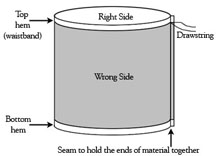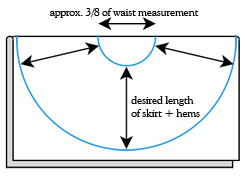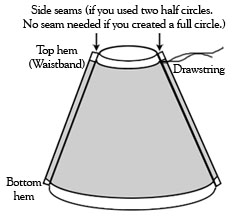In the steampunk world, I am Lucretia Strange, the Baroness Strange. I run the Promethean Society, and do a variety of presentations at steampunk conventions.
In the real world, I am Cassie Beyer and a historian with a blog, History, Interrupted, devoted to history, steampunk, costuming, popular culture and other eclectic interests.
You can best reach me through the Promethean Society or through Cassie@AlterEgoDesign.net. AlterEgo is my freelance web design endeavor focused on small businesses, individuals and organizations.
Skirting the Issue - DIY Skirts
If you're wanting a complex skirt and are not an experienced sewer, be prepared to shell out some money. Even relatively simple skirts often run $50-$90 online. If you're willing to do just a bit of sewing, however, you can save yourself a small fortune.
If you're totally new to sewing, check out the sewing basics.
 The I-Can't-Sew Skirt
The I-Can't-Sew Skirt
The absolutely easiest method is to simply take a rectangle of fabric, join the short ends with a seam, hem the top and bottom and run an elastic band (or a drawstring, although they tend to loosen with wear, particularly for heavier materials) through the top hem. There is, however, a major drawback.
While this can work for a narrow skirt, Victorian (and steampunk) skirts are wide and flowing. The bottom hem will likely be at least three yards long, while the average waist is about one yard (36 inches). That means bunching up fabric to a third of its length at the waist. Depending on your fabric, that can become bulky, so this works best with thinner materials.
Read more: Curtain to Skirt in One Hour
The Circle Skirt
The solution to this problem is to make the top hemline much shorter than the bottom hemline, and the simplest way to do that is the circle skirt. Your fabric might not be wide enough for a whole circle (particularly if you're aiming for a floor length skirt), in which case we'll need to make two half circles and sew them together.
The below illustration demonstrates how to cut if your fabric is large enough for an entire circle: fold it over and create two half circles. If the fabric is not large enough, layer two separate pieces of material and then create your half circles. Cut along the blue lines.

The inner circle will be the skirt's waist. The circumference needs to be several inches larger than your waist. Otherwise, you won't be able to put it on. A drawstring or elastic band will take up the slack afterward.

You may want to mock this up in a cheap fabric first, for two reasons:
- Make sure the length is correct
- Make sure the waist is the right size. if the hole is too:
- small, you won't be able to put it on. However, you can cut more fabric to widen it. This will, however, shorten the distance between waist and bottom hem, effectively shortening the dress.
- large, you can pull it closed with the drawstring or elastic band, but too much material gets us back to the original reason why we're making a circle skirt to begin with.